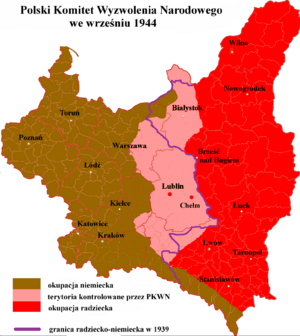Polish Committee of National Liberation facts for kids
The Polish Committee of National Liberation (in Polish: Polski Komitet Wyzwolenia Narodowego), often called the PKWN or the Lublin Committee, was a temporary government in Poland during the later part of World War II. It was set up by communists who had the strong support of the Soviet Union.
The PKWN was officially announced on July 22, 1944, in a town called Chełm. A few days later, on July 26, it moved to Lublin, which became its main base. This new government was formally guided by the State National Council (KRN).
The PKWN was created to be a rival to the Polish government-in-exile, which was based in London and recognized by countries like the United States and the United Kingdom. The PKWN took control of Polish lands that the Soviet Red Army and the Polish People's Army had taken back from Nazi Germany. Because the Soviet Union supported and controlled it, Polish communists had a lot of power within the PKWN.
Contents
How the PKWN Was Formed
When the PKWN was created, the main Polish authority in German-occupied Poland was the Polish Underground State. This underground group was loyal to the Polish government that was in exile in London.
As the Soviet Red Army fought against German forces and moved into Poland, Joseph Stalin, the leader of the Soviet Union, and Polish communists decided to set up their own government. They wanted a government they could control.
The PKWN was formed after talks between the main Polish communist groups. These groups included the Union of Polish Patriots (ZPP) and the Polish Workers' Party (PPR). The Polish communist movement had been weakened in the 1930s, but it grew strong again with Stalin's help during the war.
The PPR had already created a secret State National Council (KRN) in Warsaw. They said this KRN was the national parliament during the war. Because of war difficulties, communist leaders from Warsaw reached Lublin later, on July 31. They fully agreed with the group from Moscow on August 15. The documents they created were dated July 21 to match the announcements made on July 22.
The PKWN Manifesto, which was announced on July 22, 1944, was first broadcast on Radio Moscow. The PKWN, based in Lublin, became known as the Lublin Committee. Even though the PKWN was given administrative power in Poland, the Soviet military still made many important decisions about how the country was run during the war.
As the Red Army and the Polish Army moved further into Poland, the PKWN gained more control over the areas that were freed. However, it did not control the eastern parts of Poland (called Kresy before the war). The Allied powers had agreed that these eastern lands would become part of the Soviet Union.
Who Were the Members of the PKWN?
The PKWN included politicians from different communist and leftist parties. Joseph Stalin had to approve these members. The chairman of the PKWN was Edward Osóbka-Morawski from the Polish Socialist Party (PPS). His deputies were Wanda Wasilewska and Andrzej Witos from the Union of Polish Patriots (ZPP).
There were fifteen members in total. These members came from the KRN and the ZPP. Officially, some were from a left-wing part of the PPS, some from the People's Party (an agrarian group), one from the Democratic Party, some from the Polish Workers' Party (PPR), and two were not officially linked to any party.
Stanisław Radkiewicz was in charge of security, and Michał Rola-Żymierski was in charge of defense. The Soviet Union had its own representative, Nikolai Bulganin. His job was to support the PKWN's government and security. He was also tasked with stopping any Polish groups that supported the London-based government.
The PKWN presented itself as a wide group of leftist and democratic parties. However, the major Polish political parties were not officially part of it. Many important positions in the PKWN were given to people who worked for the Soviet Union, not just members of the PPR. Communists controlled the security, propaganda, and military parts of the PKWN.
What Were the PKWN's Policies?
The PKWN Manifesto promised big changes, especially in land ownership. It also said that Poland's territory would expand to the west, taking land from Germany. The manifesto also stated that the PKWN would follow Poland's 1921 March Constitution. It called the Polish government-in-exile an "usurper" (someone who takes power illegally) and said the 1935 April Constitution of Poland was fascist.
At first, Polish communists did not have much support from the Polish people. The new government depended completely on Moscow. The PKWN's early rules allowed the Soviet NKVD (secret police) to control areas behind the Red Army's front lines, which meant most of Poland. They also announced that the Polish People's Army would be rebuilt under Soviet leadership.
The PKWN used both strict control and ways to gain support. It appealed to people's love for their country. It also supported cultural activities and carried out a popular land reform that had been needed for a long time. No other big revolutionary changes were made besides the land reform.
The new Polish army had many Soviet officers. Most Polish officers who were in the east had been killed in the Katyn massacre or had left the Soviet Union with Anders' Army. This new army looked like a national army and fought alongside the Soviets all the way to Berlin.
At the end of December 1944, the PKWN changed its name to the Provisional Government of the Republic of Poland (RTRP). The Soviet Union officially recognized this new government in January 1945. The government-in-exile in London was still recognized by the United States and the United Kingdom for a while. But in reality, Western countries no longer saw it as important as they tried to find an international solution for Poland's government.
See also
 In Spanish: Gobierno de Lublin para niños
In Spanish: Gobierno de Lublin para niños



